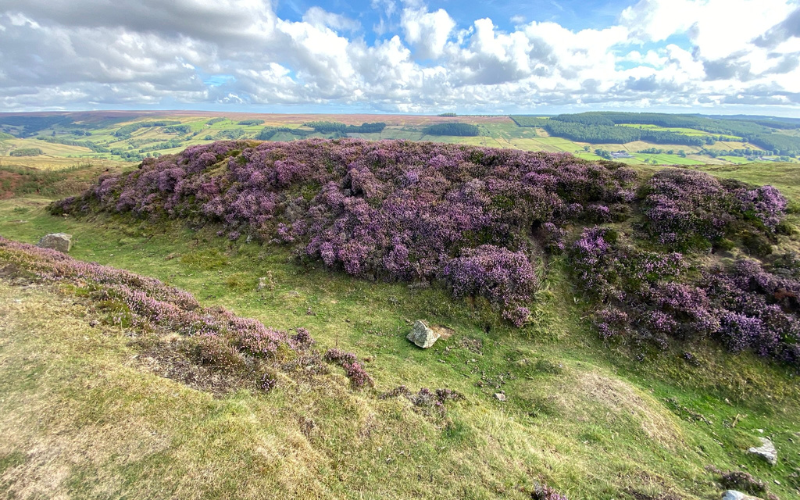Yorkshire: Plenty of Variety for the Artsy Traveler
This post may contain affiliate links to products or services I'm happy to recommend. If you click on an affiliate link and then make a purchase, Artsy Traveler may earn a small commission at no cost to you. Thank you!
I first visited Yorkshire in 1974 at the age of eighteen during my epic around-England-by-train journey with two friends (read about that trip!). The wonderful town of York quickly became our favorite because there was so much to see and do, even back in the 1970s. It’s a tourist town with several noteworthy sites including the incomparable York Minster, the York Castle Museum, and the Jorvick Viking Centre.

York also makes an excellent home base from which to explore Yorkshire. As England’s largest county (by far), Yorkshire is otherwise known as God’s Country by the locals. I have a special affinity to Yorkshire. My grandmother was born in Masham in Yorkshire and often talked fondly of her early years there, and I’ve set my fifth novel there.
In this post, I detail what to see in York and describe two full-day, small-group tours I took in 2022. As I’ve mentioned elsewhere on Artsy Traveler, I’m a big fan of small-group day tours. The two I took from York were first-rate.
York
York Minster dominates the walled city of York. A tourist mecca with plenty of shops and services for visitors, it’s also small enough to walk around easily. I recommend staying for at least two nights (and preferably three).
While in York, I visited the Yorkshire Museum, York Minster, the York Castle Museum, and Jorvick Viking Centre. In addition, I took a shamble through the Shambles and enjoyed three excellent meals.
Here are a few other tours in York offered by Get Your Guide, a company I’ve taken tours with and can recommend.
Yorkshire Museum
The Yorkshire Museum is located in the Museum Gardens, which is about a 10-minute walk from the York Railway station next to the river and from the Bootham Gate leading into the ancient center of York where York Minster is located.
The museum itself is small and probably only worth a visit if the special exhibition interests you. When I visited, an informative exhibition about the Ryedale Hoard was featured. The Ryedale Hoard is a collection of bronze Roman objects discovered by detectorists in North Yorkshire in 2020. A small bronze bust of the Roman Emperor Marcus Aurelius is the centerpiece of the collection.
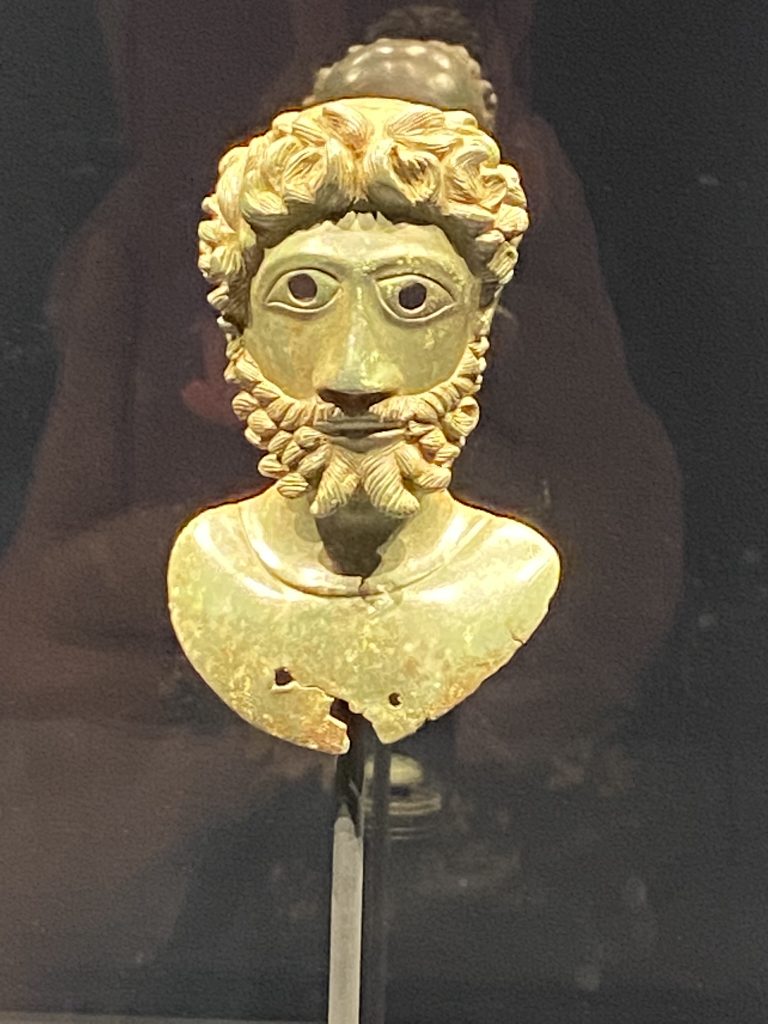
The exhibition also includes other Roman objects and interesting descriptions of who might have buried the hoard—A priest? A landowner? A metalworker? And why? That’s the Ryedale Hoard mystery.
As well, the museum features a Jurassic exhibition and plenty of medieval and Roman objects. It’s definitely worth a quick visit if you’re into history, archaeology, and geology (and who isn’t?).
Yorkshire Museum Practical Information
The Yorkshire Museum is open Tuesday – Sunday from 11 am to 5 pm. Admission is £8 online / £8.75 walk-up price for Adults and Seniors; £4 online / £4.40 walk-up price for children ages 5-16; and £7.20 / £7.90 walk-up price for Students/Young People. The website advises booking online prior to visiting the museum.
York Minster
The headliner in York is York Minster, and no wonder! The magnificent cathedral dominates the skyline of York for miles around. I’ve visited York several times, and I still got a thrill every time I turned a corner and saw the Minster’s towers poking the sky between the buildings.
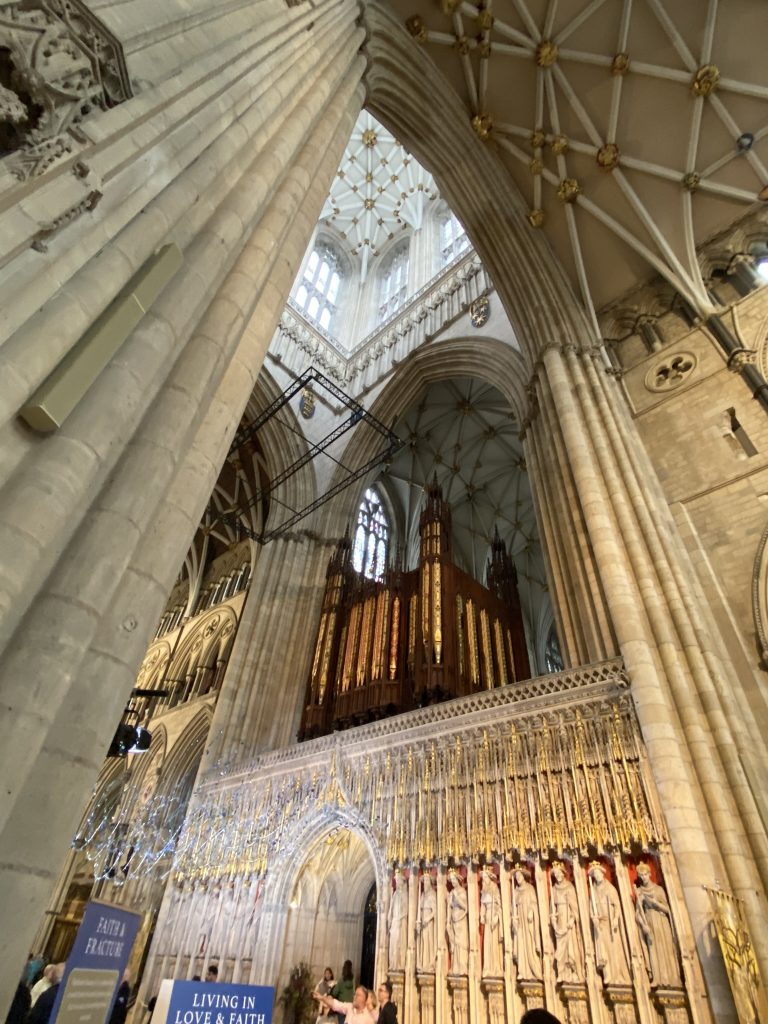
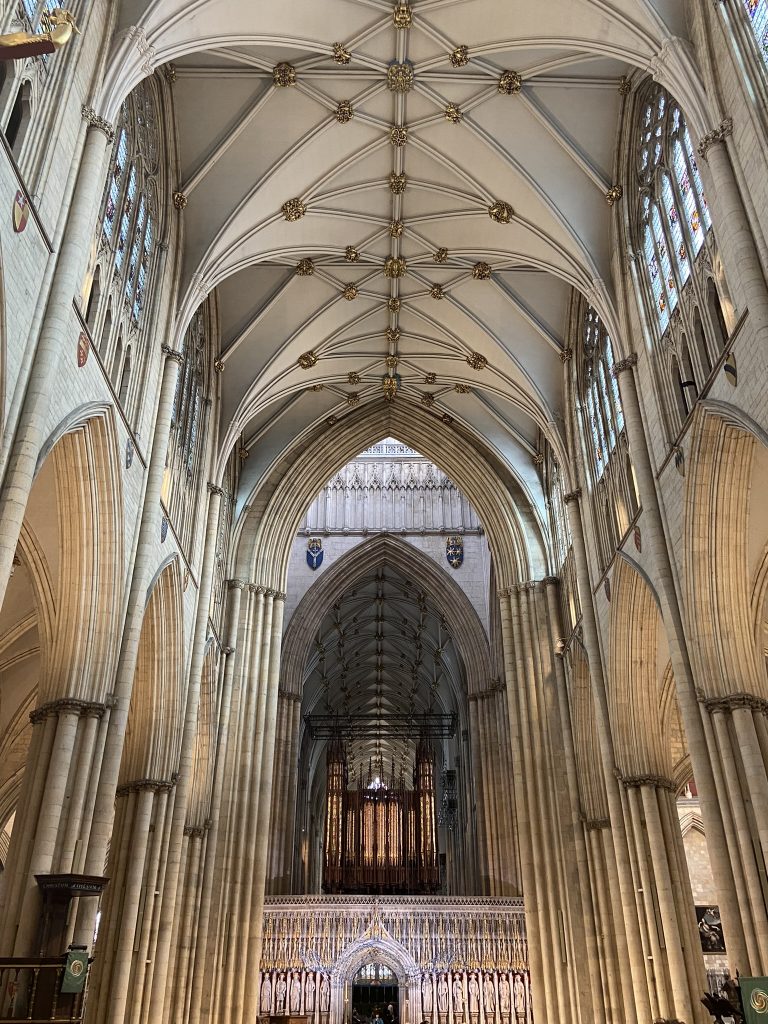
You’ll pay an admission fee to enter the Minster, but it’s money well spent. A big reason for the entrance fee is that it apparently costs £22,000 a day to keep the Minster open and operating. If you have time, visit around 5 pm to enjoy Evensong during which the choir sings accompanied by the organ–guaranteed to give you chills!
One of the coolest things about York Minster is how the facade changes with the light. I took a lot of pictures during my three-day stay. Every time I was in the vicinity of York Minster, it looked different! Here are two views.
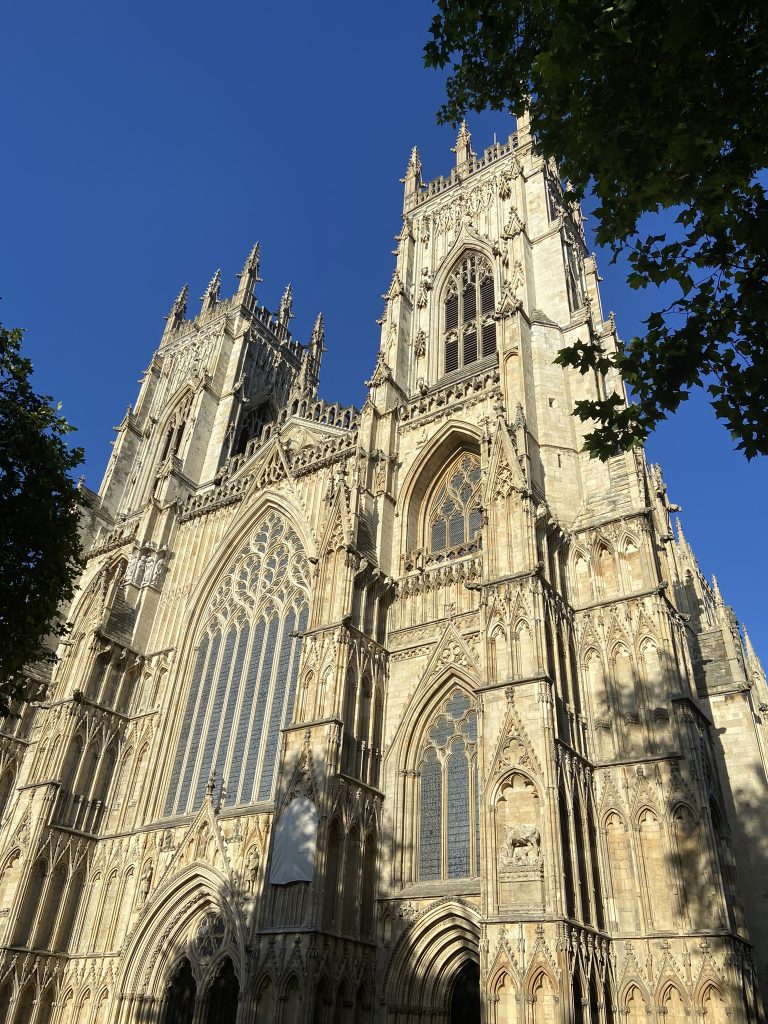
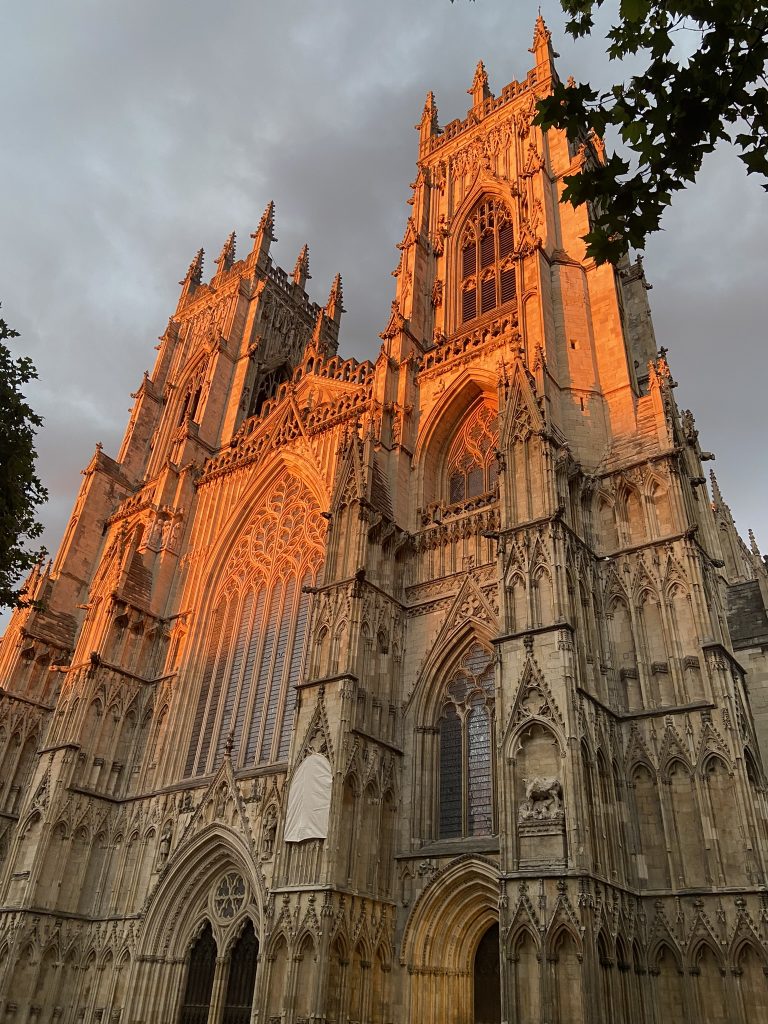
For more information about York Minster, check out this post about 18 Incredible York Minster Facts.
York Minster Practical Information
York Minster is open Monday to Saturday from 9:30 am to 4 pm and on Sunday from 12:45 pm to 3:15 pm. Online ticket prices are Adult/Senior – £12.50; Students (not studying in York) – £9.50; Child (16 and under)* – free with a paying adult; York resident/York student – free with proof of address. Check the York Minster website to buy tickets online and also to check times for Evensong.
York Castle Museum
York Castle Museum is one of my favorite all-round cool museums in Britain. You can spend hours here prowling through the many exhibits designed to bring history to life.
I particularly enjoyed the re-creations of rooms from past eras. Here are two of them.
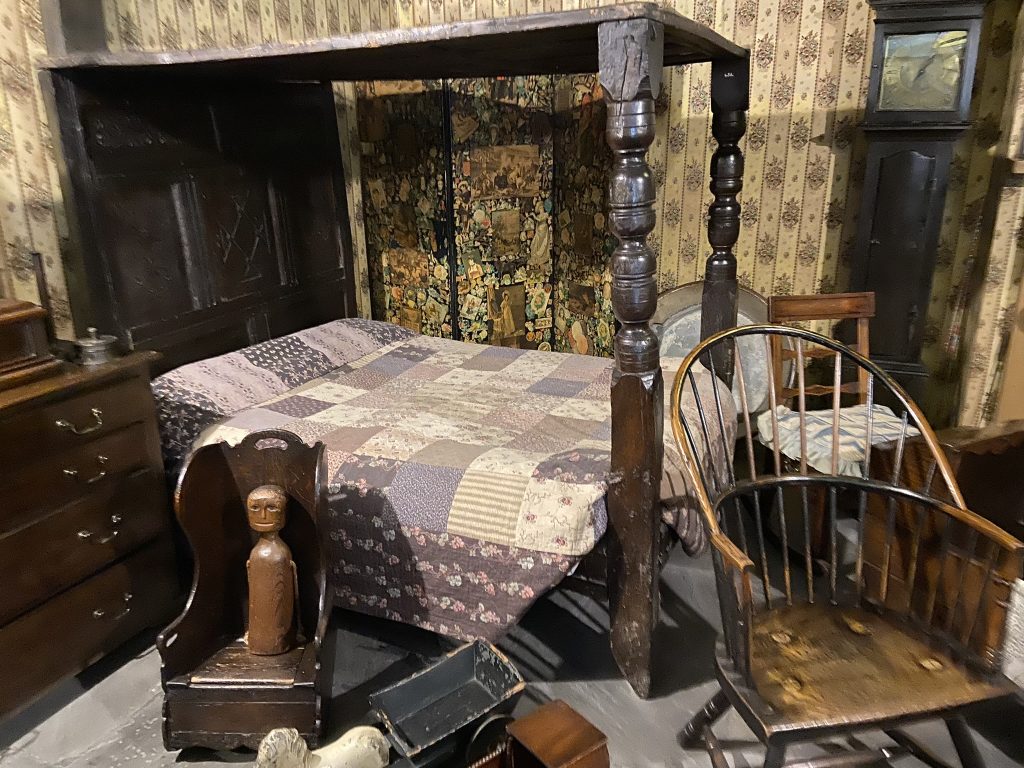
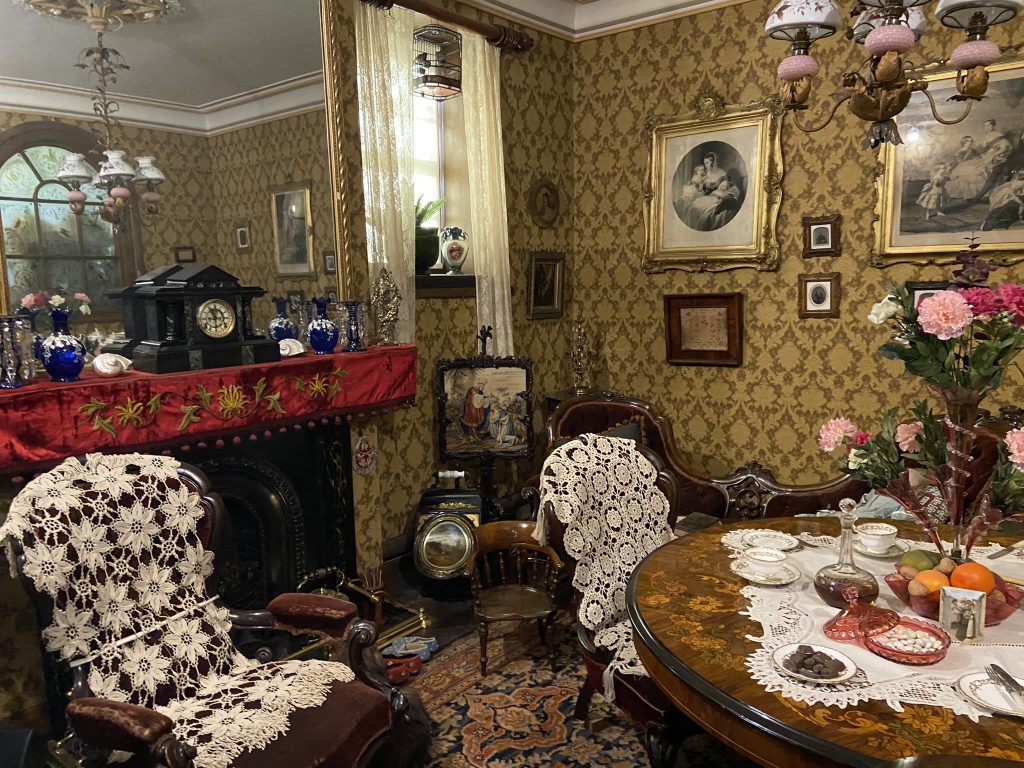
Another favorite room features costumes dating from the early 19th century to the present day. I got a kick out of this coat from the early 1970s, which is very similar to one I owned in 1974 when I was a student at Reading University!

I spent quite a bit of time watching videos that bring to life the differences between work in the “olden” days and now. Two people–one from modern times and one from the early 1900s–spoke about their jobs. A maid in a country house talked with a cashier in a modern supermarket; a bank clerk from 1900 talked with a modern office worker, and so on. I was fascinated and had to watch all of the variations! The nature and quantity of work certainly has changed over the centuries.
One area of the museum is devoted to displaying full-size recreated streets from the early 20th century. Costumed guides happy to share their knowledge staff many of the shops.
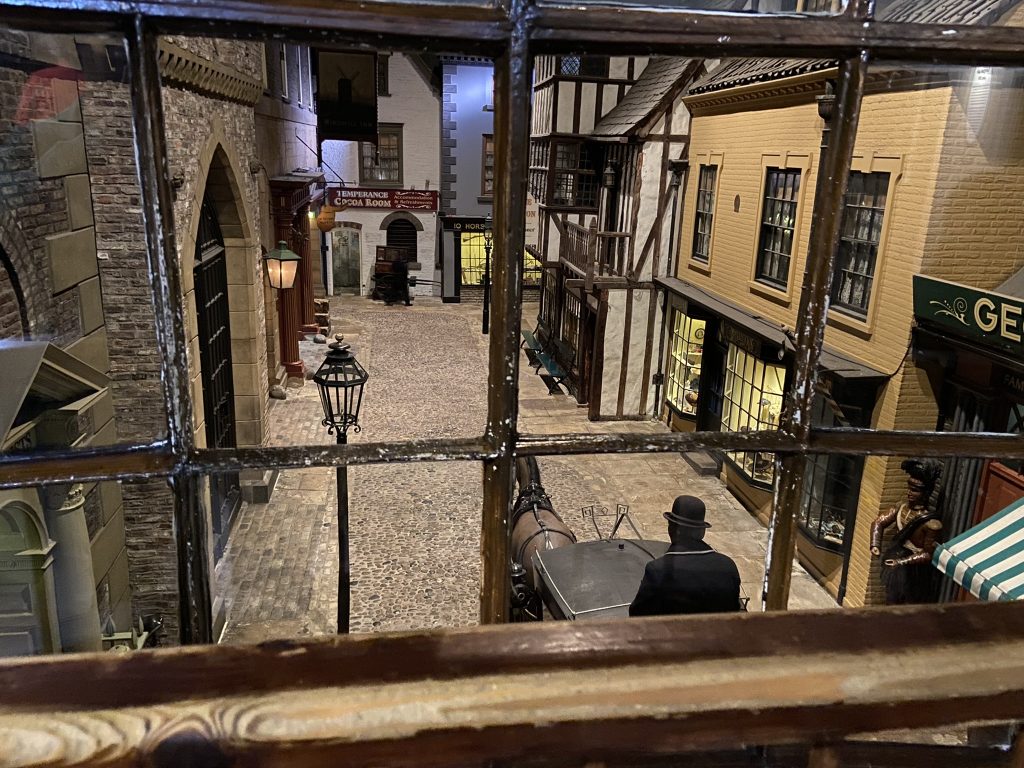
York Castle Museum Practical Information
The York Castle Museum is open Monday from 11 am to 5 pm and Tuesday to Sunday from 10 am to 5 pm. Admission is £13 online / £14 walk-up price for Adults and Seniors; £6.50 online / £7 walk-up price for children ages 5-16; and £11.70 / £12.60 walk-up price for Students/Young People. The website advises booking online prior to visiting the museum.
Jorvik Viking Centre
The Jorvik Viking Centre is touted as a major attraction in York and for good reason. It’s kind of cheesy, to be honest, but it’s still worth visiting to get a sense of what life was like back in the 800s when York was a Viking town.
After arriving at the Jorvik Viking Centre, I boarded a slow-moving, Disney-style ride (think It’s a Small World) and was whisked (slowly) away on a journey through a Viking town. Commentary is available in multiple languages. The dioramas and figures are life-like and give a pretty good sense of how the world might have looked back in the day. All that’s missing are the smells!
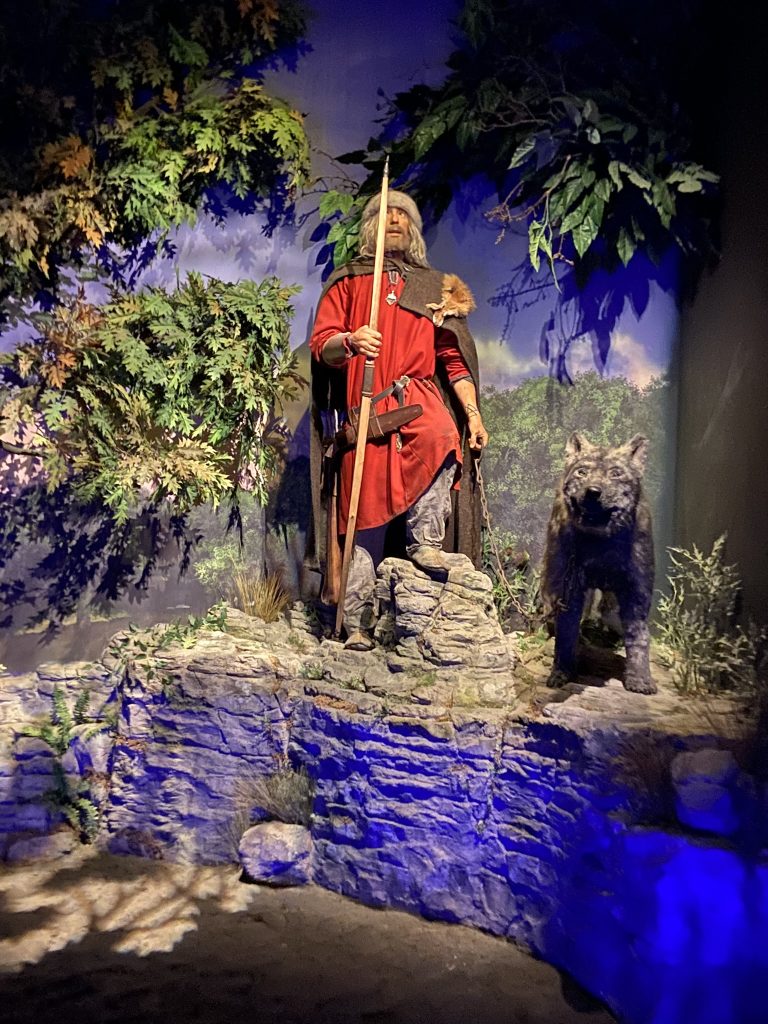
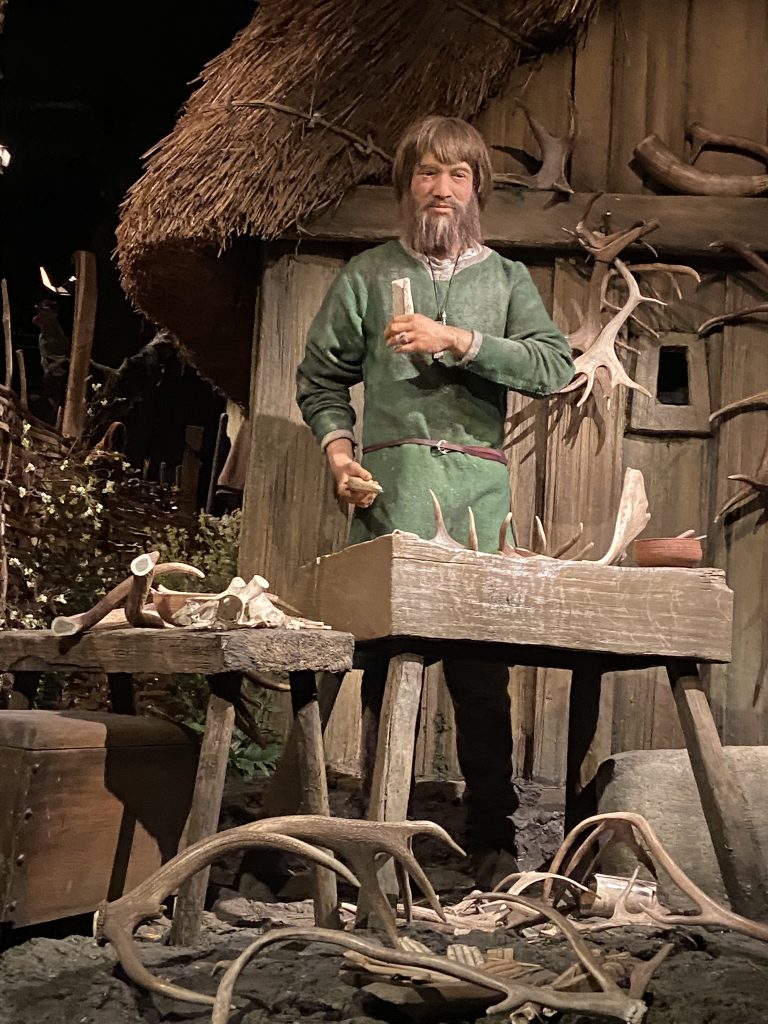
I enjoyed the ride and the displays afterwards. Good-humored, costumed guides occasionally give demonstrations of various Viking crafts. A real Viking village was probably not quite so jolly.
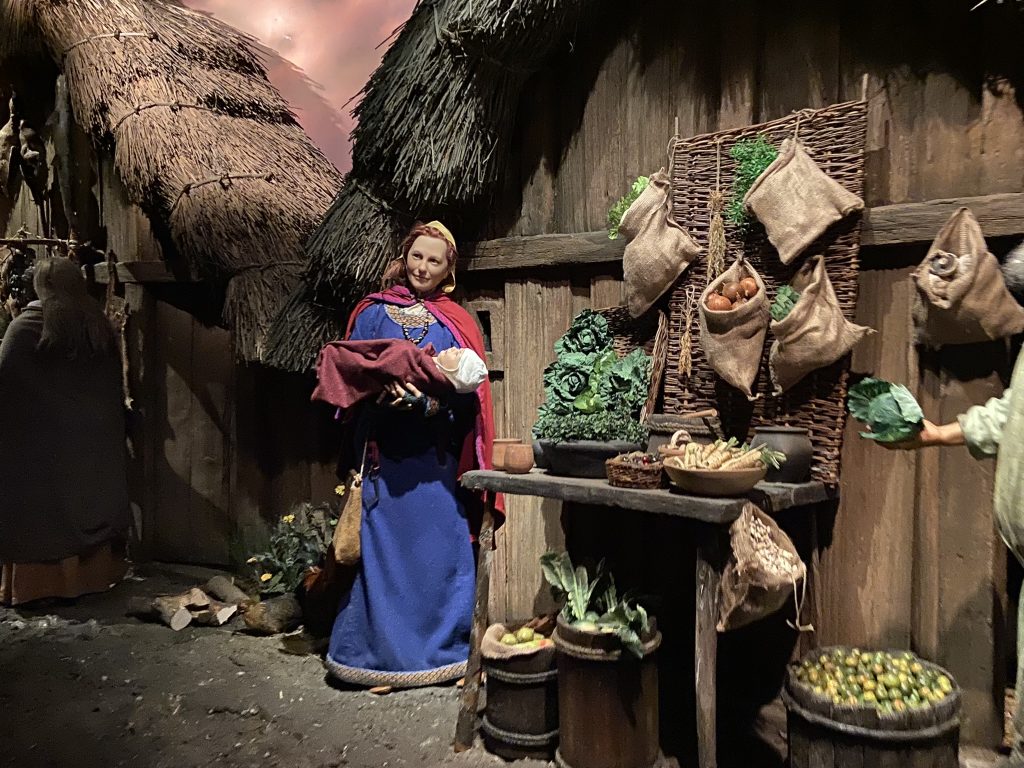
Jorvik Viking Centre Practical Information
The Jorvik Viking Centre is usually open from 10 am to 6 pm. Check the website for varying hours depending on the time of year. The Centre is a very popular tourist destination. Book your visit a few days in advance to select the time you want to visit and also avoid disappointment. Popular time slots sell out quickly. Admission is £13.50 for Adults; £9.50 for children ages 5-16 accompanied by an adult; £11.50 for students with valid student ID, and £11.50 for seniors 60+. Visit the website to book online.
The Shambles
The Shambles is a touristy but still fun street in York. Although only a block long, the street is one of the few remaining in Britain that retains its medieval character. Buildings jut out over the narrow street which is more like an alleyway.
Capitalizing on the Harry Potter franchise, the street contains several “magic” stores. The area is worth a quick walk through, preferably in the evening after the crowds of tourists have somewhat dissipated.
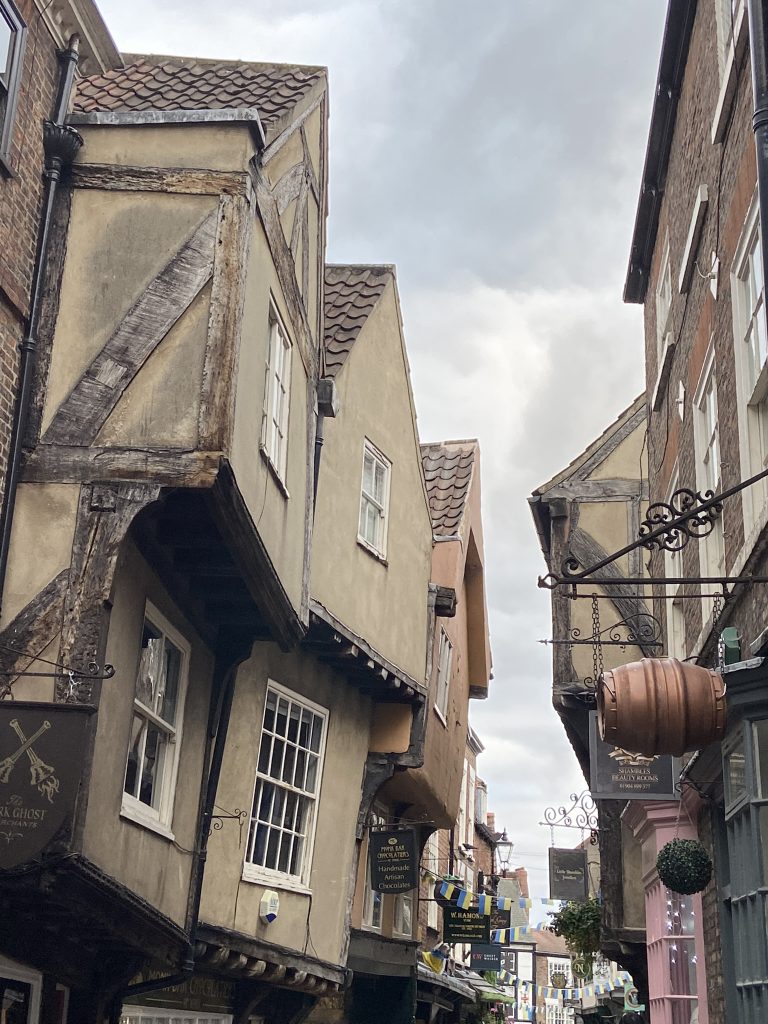
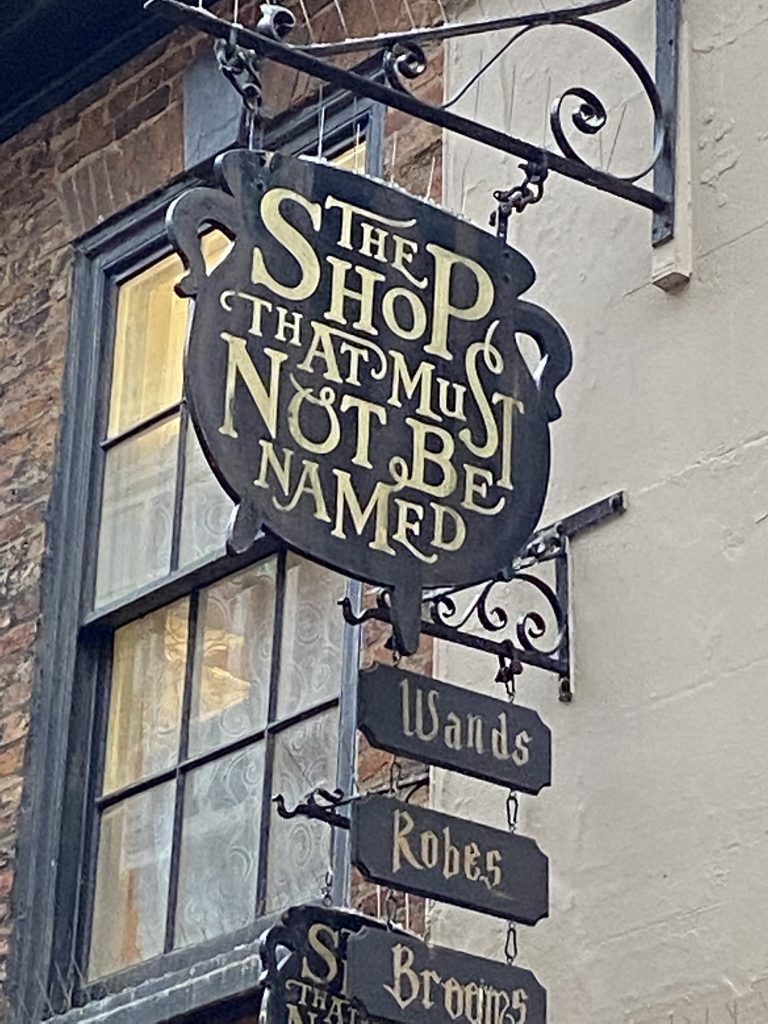
Yorkshire Moors Tour
I signed up for a full-day tour of the moors with Grand Yorkshire Tours. Called “Steam Trains, Whitby & the Moors”, the tour promises a full day with no more than seven people in a small minivan. Hotel pickup and steam train tickets are included.
At exactly 9 am, as promised, the driver pulls up in front of Jorvik House Hotel and I jump into the minivan where my six companions are already settled: a couple from Florida, a man from Colorado Springs, another couple from Cheltenham in the UK, and a woman from Tunisia who has lived for many years in the US.
And me, as usual the lone Canadian.
Our driver, Peter, is a Yorkshire native who takes us on a comprehensive tour through several of Yorkshire’s scenic hot spots. Yorkshire is so large that I book another tour for the following day that features the Yorkshire Dales because the itineraries are completely different.
Helmsley
Our first stop is the idyllic little town of Helmsley on the edge of the North York Moors National Park where our driver is from. He advises us to take the iconic shot of the church (see below), which I of course do.
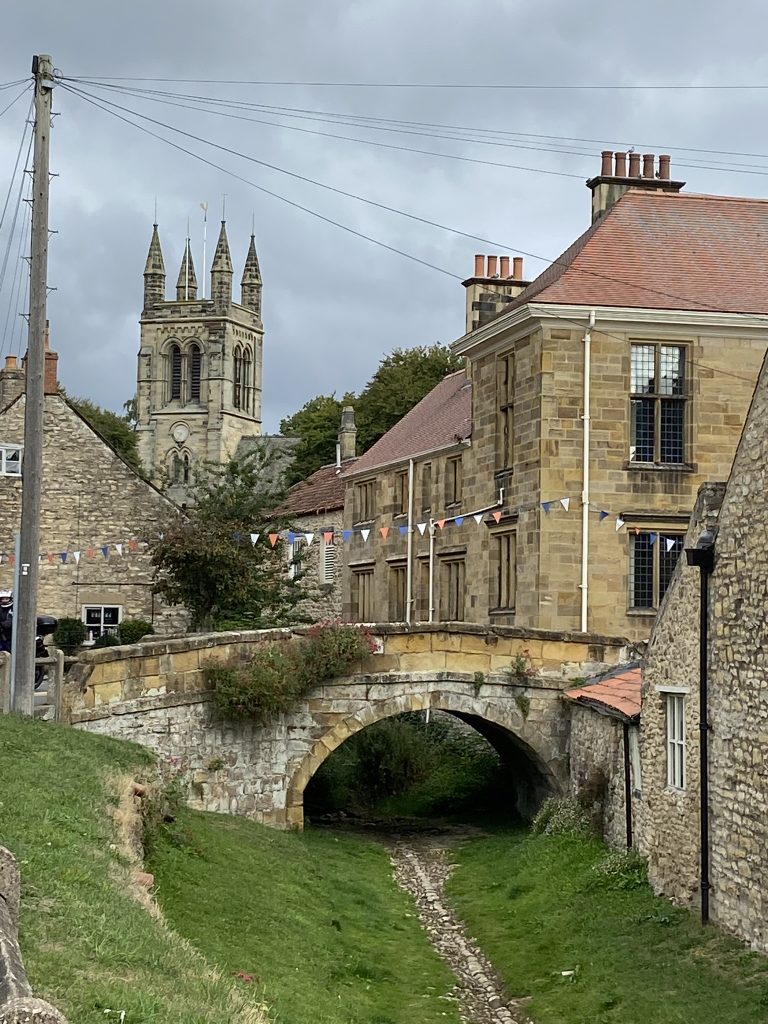
With my touristic duty done, I take stock of Helmsley’s many scrummy-looking bakeries and tea shops. I try to resist the siren call of the scones, but in vain. I buy two. One is chock-a-block with candied fruit and the other packed full of cheese.
Both are achingly fresh and fluffy and buttery.
Yorkshire Moors
We drive up into the Yorkshire moors and learn about the history of the area—from Romans to Vikings to the Middle Ages and then the reformation which certainly caused a lot of damage to local monasteries and churches. The views are stunning.
I’m lucky to be visiting at the tail end of heather season. Clumps of vivid purple carpet large swathes of the brown moors. Every so often, a sheep wanders by. As Peter says, we are driving through their home since most sheep live on the moors year round.
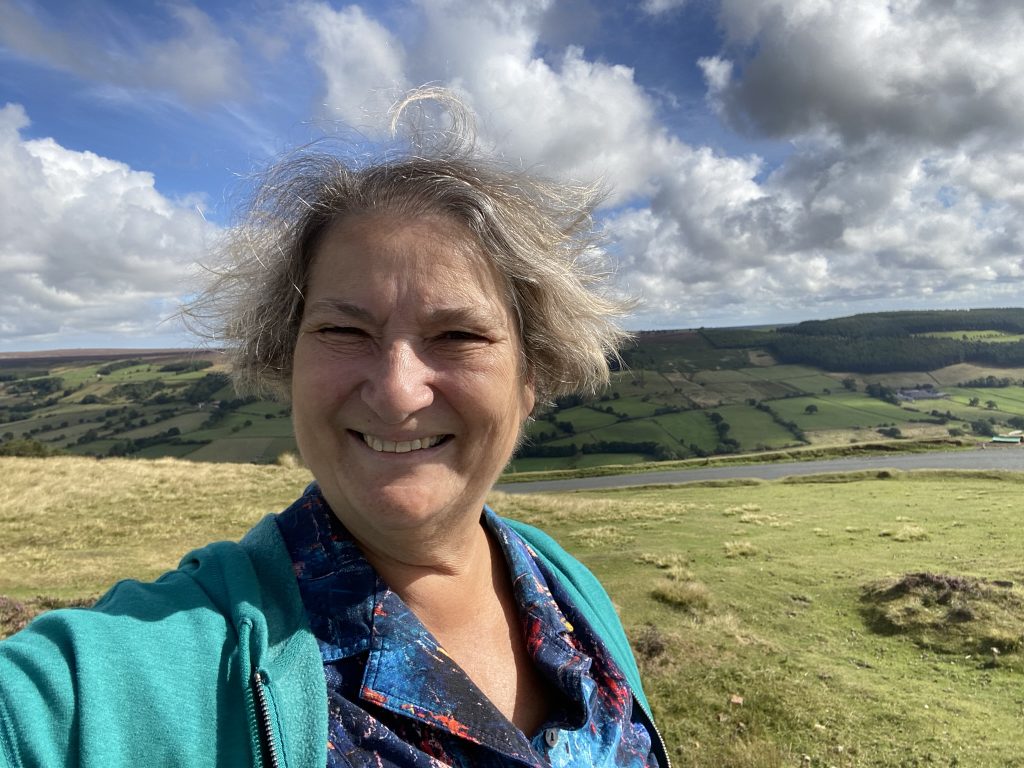
I learn that heather moorland is rare compared to other types of land. One of the world’s largest continuous expanses of upland heather moorland is in the North York Moors.
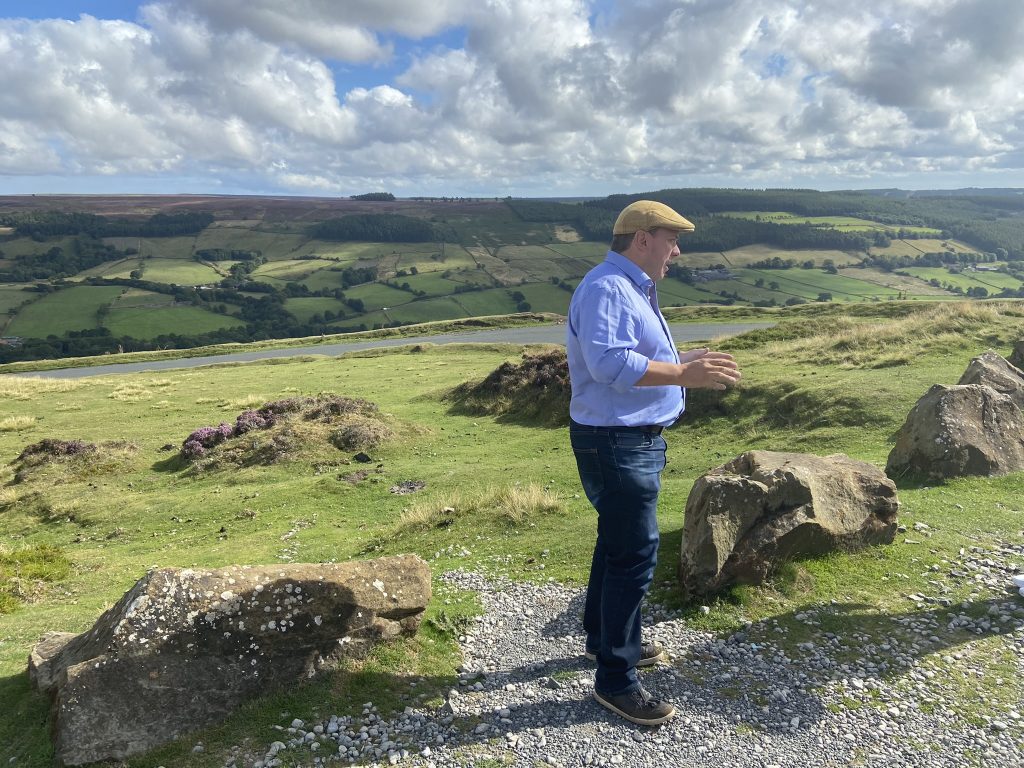
I also learn that the moors are actually man-made. The landscape looks so wild that it’s hard to believe it hasn’t always looked that way. But nope. As early as the Iron Age 4,000 years ago, people were wanting to farm crops and pasture animals.
They cut down the vast forests that had covered the area to make clearings for farms. As the population grew, the forests diminished until by the Middle Ages, most of the woodland had disappeared.
Here’s a video shot atop the Yorkshire moors. Spectacular!
Whitby
The seaside town of Whitby is a revelation. The only thing I know about Whitby is that it’s on the sea. As a result, I’m pleasantly surprised to discover a fabulous abbey perched high on cliffs overlooking the sparkling blue North Sea, a charming old town, the best fish and chips in the UK (their claim and it seems valid), a Captain Cook Museum, and a major connection to Dracula.
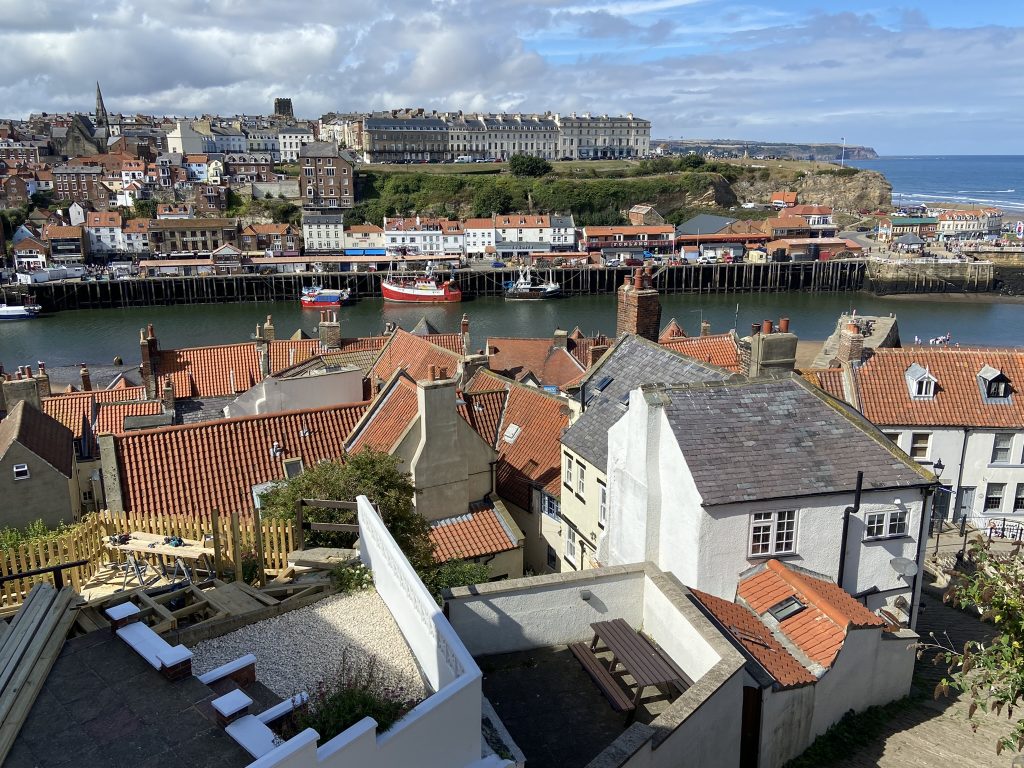
Goths Rule in Whitby
Wander the streets of Whitby and you’ll eventually come across young women (and sometimes men) dressed head to toe in artfully tattered black clothes and wearing heavy black make-up and an earnest expression. You’ll be right to presume they are visiting Whitby because of the Dracula connection.
Twice I pass a family that makes me smile. Mum and Dad are typical middle-class English folks—the kind of conservatively dressed, comfortable-looking people you see every day. Their daughter, however, wears a long black gown (tattered, of course), carries a black parasol, and is wearing the most outlandish black eye make-up I’ve ever seen. The three of them wander around the Abbey ruins and then later I see them in the town enjoying fish and chips. The daughter’s appearance barely merits the occasional glance from passersby.
Bram Stoker & Whitby
Bram Stoker arrived in Whitby in July of 1890. The windswept headland and spooky abbey ruins combined with the atmospheric old town and North Sea views were ripe for exploiting by an over-active imagination (which Stoker had in spades).
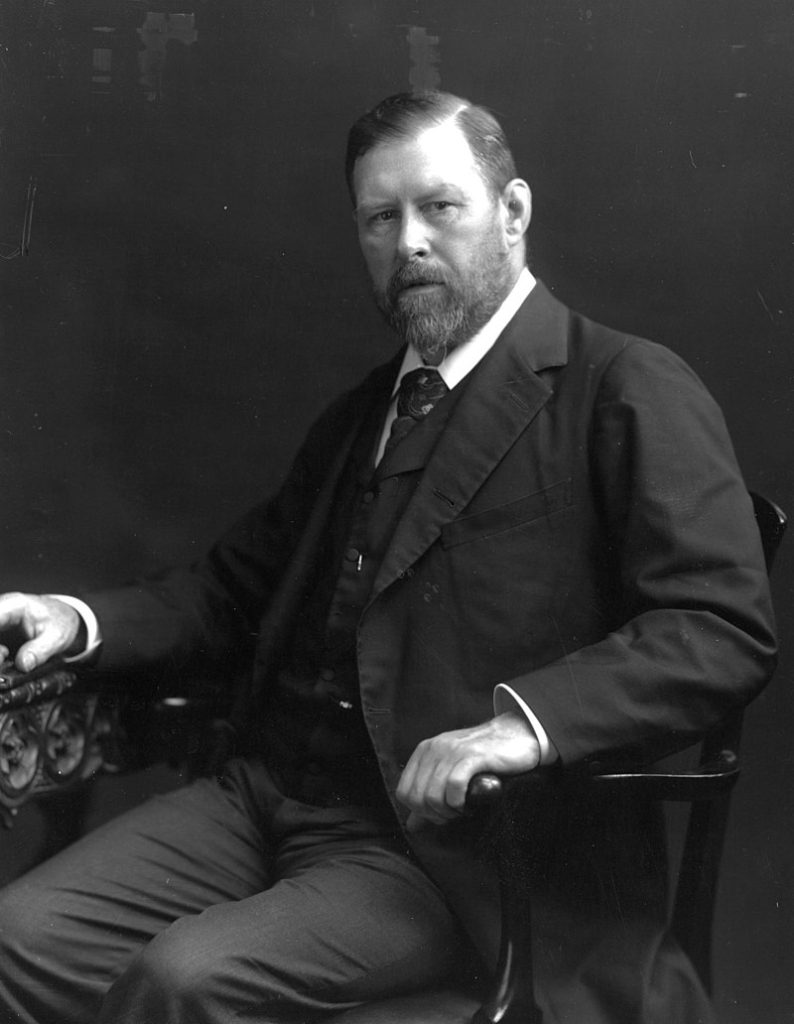
He hung around the town for a few weeks presumably enjoying the sea air before fate stepped in. Stoker visited the local library and discovered a book published in 1820 that recorded the experiences of William Wilkinson, a British consul in Bucharest. While traveling in Wallachia and Moldavia (now in Romania), Wilkinson learned about Vlad Tepes, a charming fellow known as Dracula, aka “son of the dragon.” He had a not-so-charming habit of impaling his enemies on wooden stakes.
Anyway, Bram Stoker’s imagination went into overdrive and 130 years later, heavily gothed-up young people take day trips to Whitby to wander the Abbey ruins, presumably with vampiric intentions, and then descend the 199 steps to the old town to enjoy fish and chips followed by teeth-breaking encounters with pieces of Whitby rock (an iconic hard candy with a vivid pink coating).
Whitby Abbey
Peter drops us off at the Abbey and advises us to walk down the 199 steps to the town and meet him two hours later at the train station. The weather obliges with brilliant blue skies against which the Abbey ruins photograph beautifully. I wander around the ruins for a while, dodging the occasional Goth girl, and have a quick look in the museum.


I read that on May 26, 2022, which is the 125th anniversary of Bram Stoker’s novel Dracula, 1,369 vampires showed up to celebrate. The event was billed as the largest gathering of people dressed as vampires in the world. Now that’s an event to really get your teeth into.
The first Whitby Abbey was a 7th-century Christian monastery that later became a Benedictine abbey. It was a major center of learning for about 800 years until it was confiscated and then destroyed by Henry VIII during the dissolution of the monasteries (1536-1545). Henry certainly was busy in the area.
Descending 199 Steps to the Old Town of Whitby
I am glad to be descending the steps rather than ascending. Many more people are climbing up and I’m a bit alarmed by the look of some them as, red-faced and panting, they struggle up the stairs.
Every few feet, I pause to snap yet another gorgeous photo until finally I’m walking along the narrow, twisty streets of the old town.

The Captain Cook Memorial Museum is nearby but, cognizant of the need to have lunch and then be on time for the bus, I reluctantly pass on it. I head across the bridge to the new town and buy a take-away of fish and chips.
Eating in Whitby
I’ve never seen so many fish and chips shops, ice cream parlors, and candy stores in one place in my life. And business is brisk. Although it’s the day after the Monday bank holiday, the streets are packed with holiday makers.
For just £8.50 (including a can of pop), my lunch is an amazing bargain. The piece of haddock is huge and absolutely the best I’ve ever tasted. Crunchy light batter coats a thick piece of meaty white haddock that tastes light and of the sea. Marvelous!
I settle on to a bench alongside the harbor and watch the world go by as I enjoy my fish and chips. Judging from the conversations I overhear, pretty much everyone is local. And almost everyone has a dog—from whippets and dachshunds to spaniels and labs and everything in between.

Taking the Steam Train
After Whitby, our next stop is tiny Goathland station, made famous in the Harry Potter movies as the location of Hogsmeade station. Part of the tour includes a one-hour ride on the steam train that journeys along the North Yorkshire Moors Railway to the town of Pickering.
Unfortunately, an exceedingly dry summer has resulted in a ban on steam engines. Apparently, they pose a fire hazard. As a result, the carriages are drawn by a common-or-garden diesel engine which is a bit of a disappointment but can’t be helped.
Here is the train pulling into the station–a video that would be a bit more dramatic if the train was the regular steam train, but you get the idea.
The journey takes us through dark forests and across wide expanses to purple heather and dry yellow grasses. I marvel at the quantity of wild land in such a crowded country.
Church of St. Peter and St. Paul in Pickering
Our last stop before driving back to York is the Church of St. Peter and St. Paul, a typical small parish church with a not-so-typical interior. The original Norman church was built around 1140 and then in 1450 a series of colorful medieval wall murals were painted.
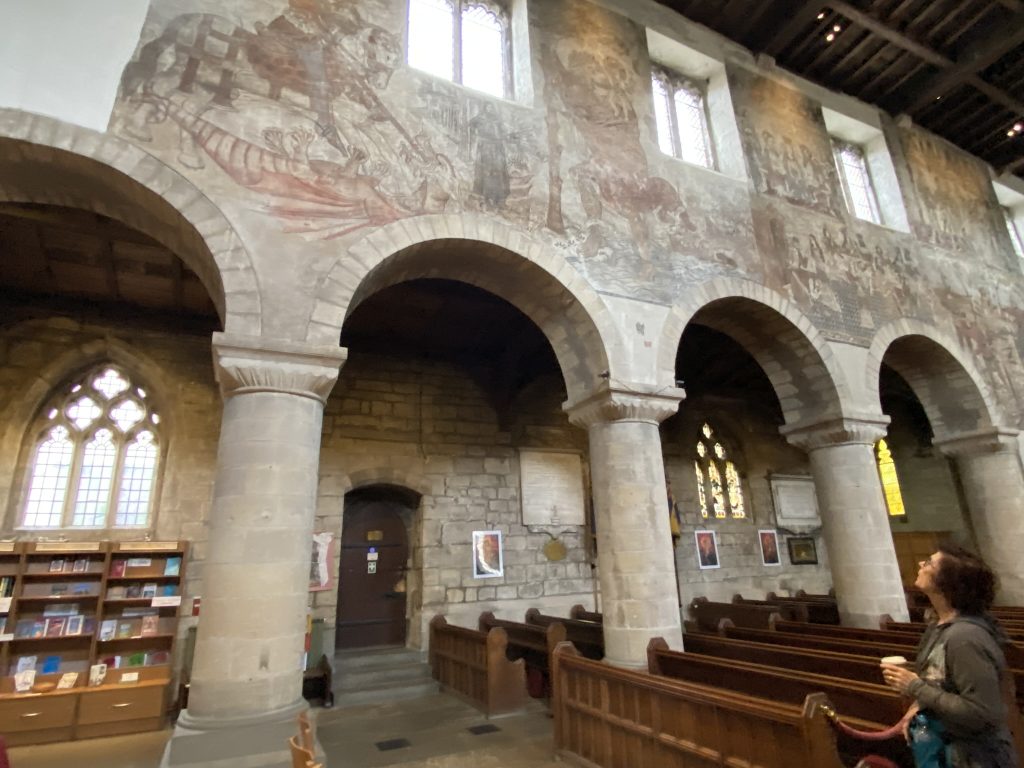
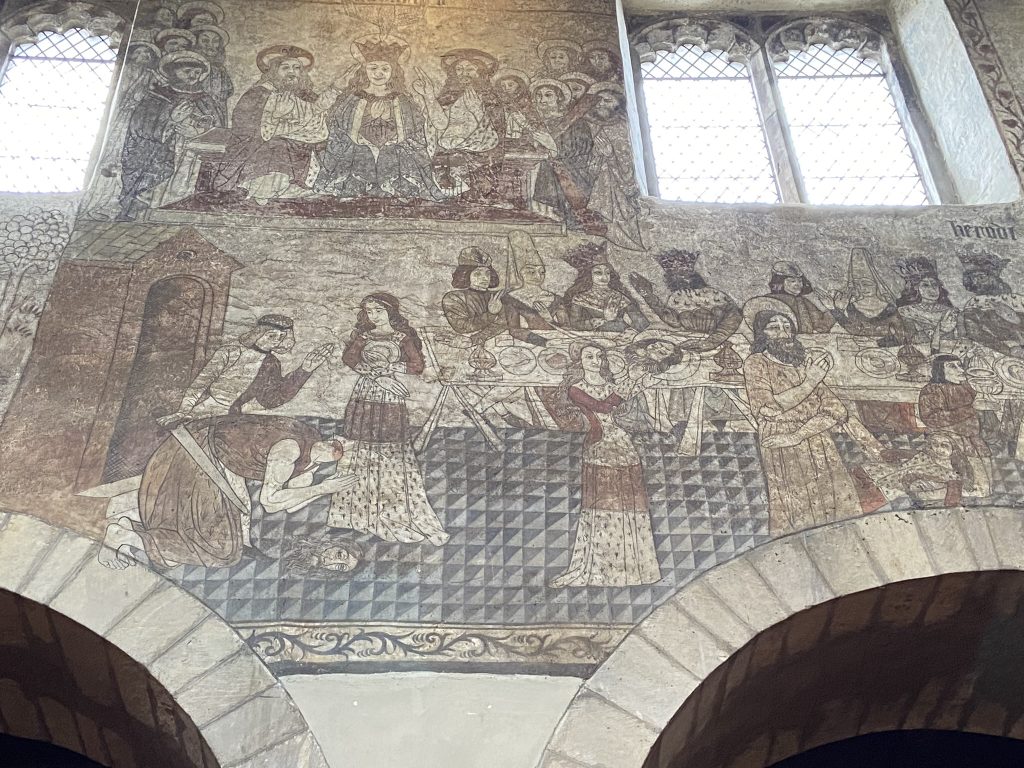
Back in the day, the walls of most churches were filled with colorful paintings depicting Biblical scenes for the vast majority of parishioners who could not read. Come the Reformation and then the Civil War, religious types with different views whitewashed the paintings.
In 1852, the paintings were revealed; however, the vicar at the time apparently did not want the paintings shown, saying that “As a work of art [they are] fairly ridiculous, would excite feelings of curiosity, and distract the congregation.”
I’ll bet he wasn’t a lot of fun at a party.
He ordered the paintings be re-covered with a thick yellow wash that was finally removed in the 1880s and 1890s. The resulting paintings, while extensively damaged, are a fabulous example of how most church interiors originally looked. Unfortunately, only about five churches in the country still have their original murals, with the ones in St. Peter and St. Paul being of particularly fine quality.
A Hidden Gem
For the wandering Artsy Traveler, the paintings are a hidden gem. Peter tells us that almost no one knows about the paintings. One of the many benefits of taking small-group tours is the chance to explore such off-the-beaten-path sites.
Return to York
We drive back to York and I enjoy a first-rate pub meal at The House of the Trembling Madness. I love this place! The upstairs room in the medieval building dates from the 12st century and has all the heavy wooden beams and stuffed critters on the walls to prove it. I order the Yorkshire Platter and am in heaven.
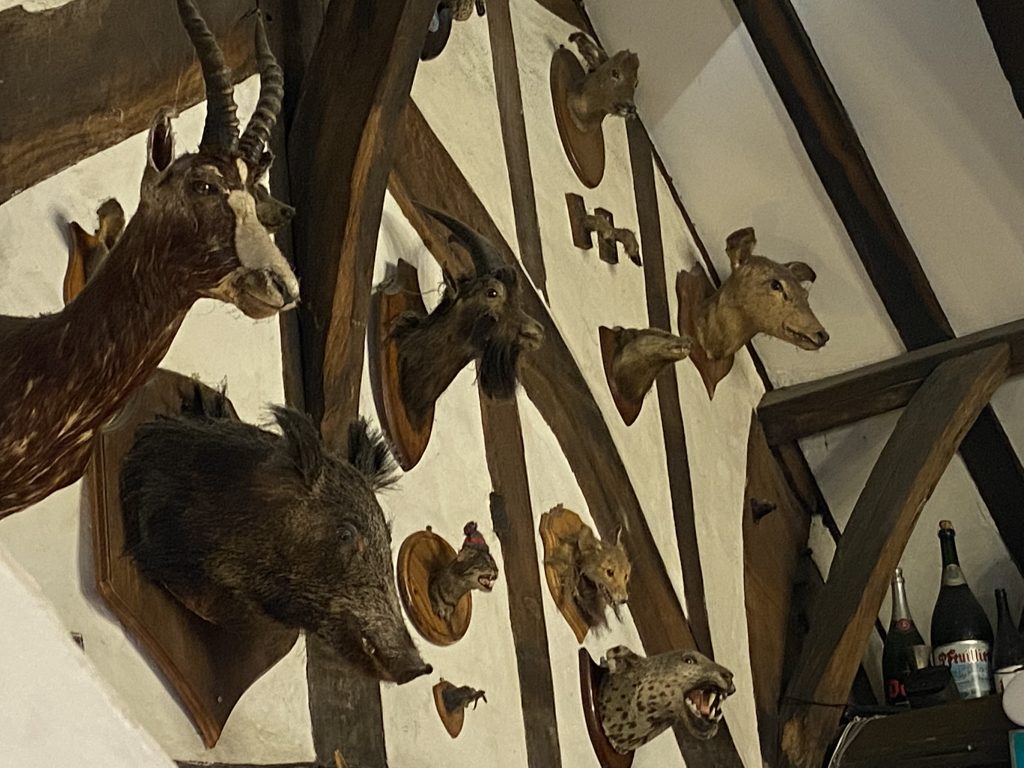
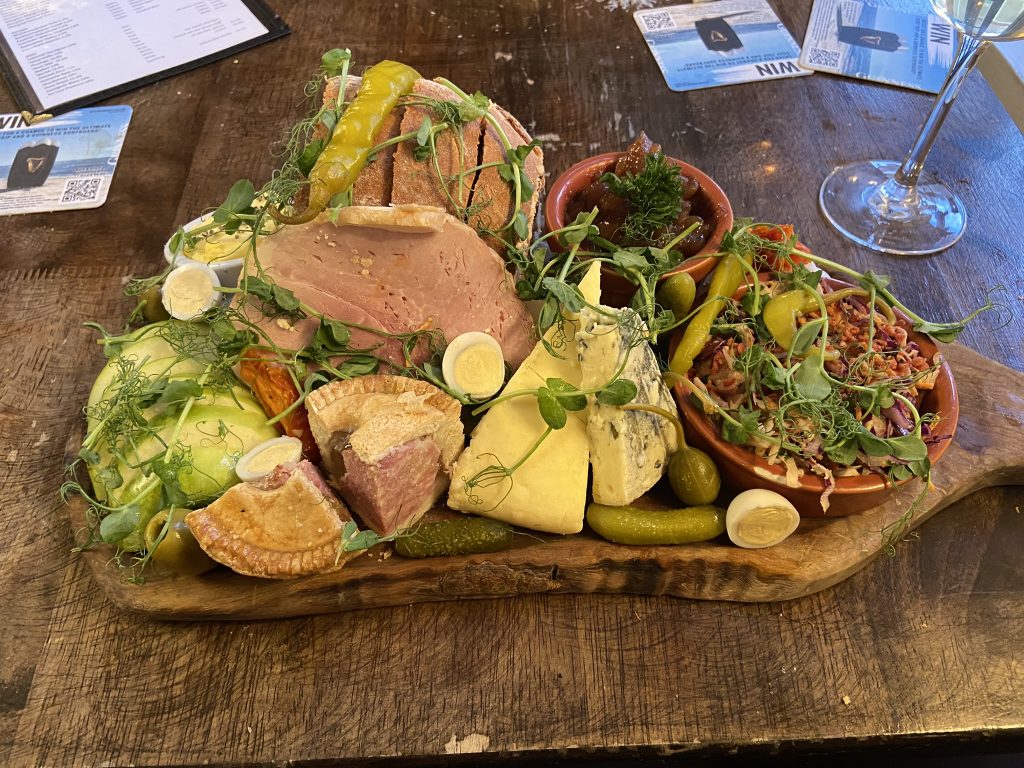
Yorkshire Dales Tour
I choose a different company for my second tour of Yorkshire—this time of the Yorkshire Dales with Mountain Goat Tours. Like the Go Cotswolds tour, the Mountain Goat tours use 16-seater minibusses which are small enough to navigate the tiny mountain roads we’ll traverse during the course of the day.
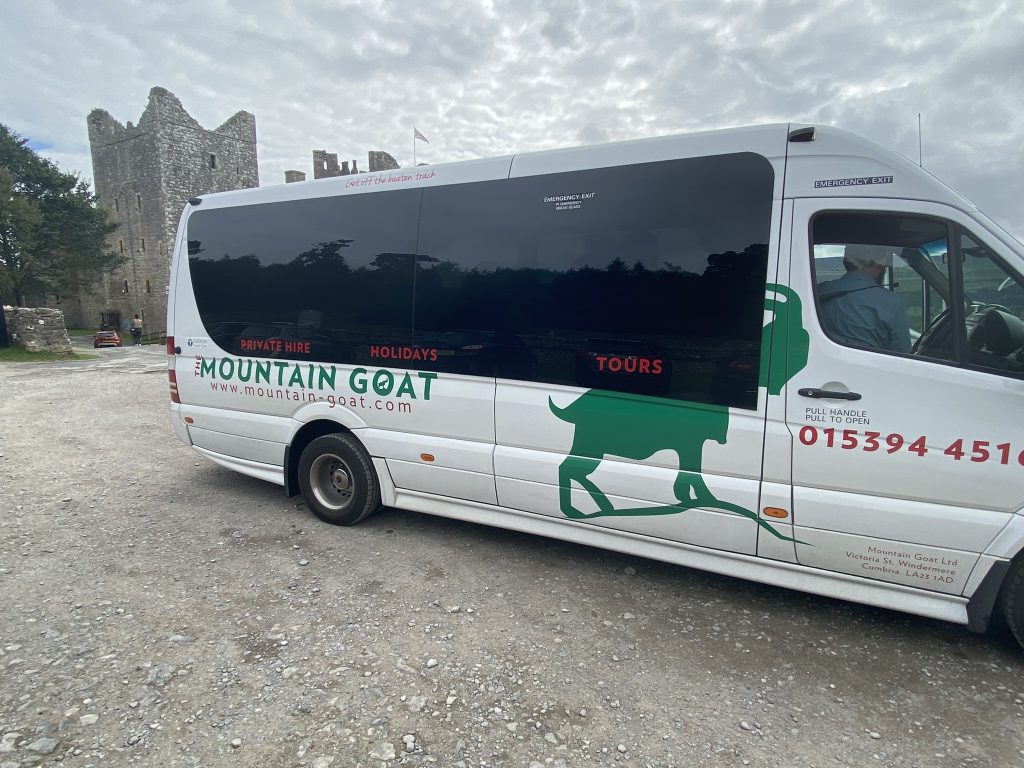
Matt, our guide and driver, is friendly, knowledgeable, and very enthusiastic about responsible tourism. He tells us that he’s doing his master’s degree in tourism management and has been conducting tours with Mountain Goat for several years. The company provides day tours in scenic areas all over the north including the Lake District, North Wales, and, of course, Yorkshire.
A Short History of Yorkshire
As we head out of York, Matt gives us a short history of the area, explaining how it was first settled by the Romans and then the Anglo Saxons, the Vikings, and the Normans in 1066. He tells us about the Harrying of the North, which I’d never heard of even though I lived in Durham, which is pretty close to York, for a year in the 1970s.
After conquering southern England, William the Conqueror turned his attention to subjugating the North. The people of the North were none too pleased and had the nerve to rebel against William. He retaliated with swift brutality by using scorched earth tactics to destroy the northern shires, particularly in the city of York. Even for the time, William’s viciousness was breathtaking.
Harrying of the North
After the tour, I go online to learn more about the Harrying of the North and read this account by Orderic Vitalis, a contemporary chronicler. In 1069, he wrote:
“Nowhere else had William shown so much cruelty. Shamefully he succumbed to this vice, for he made no effort to restrain his fury and punished the innocent with the guilty. In his anger he commanded that all crops and herds, chattels and food of every kind should be brought together and burned to ashes with consuming fire, so that the whole region north of the Humber might be stripped of all means of sustenance. In consequence so serious a scarcity was felt in England, and so terrible a famine fell upon the humble and defenceless populace, that more than 100,000 Christian folk of both sexes, young and old alike, perished of hunger.” Source
No wonder that to this day people in the north are often not terribly keen on southerners!
Masham
Our first stop is the town of Masham, a market town where the smell of beer brewing in the local breweries hangs in the air and the attractive town square is lined with stone buildings that look unchanged for a century or two.
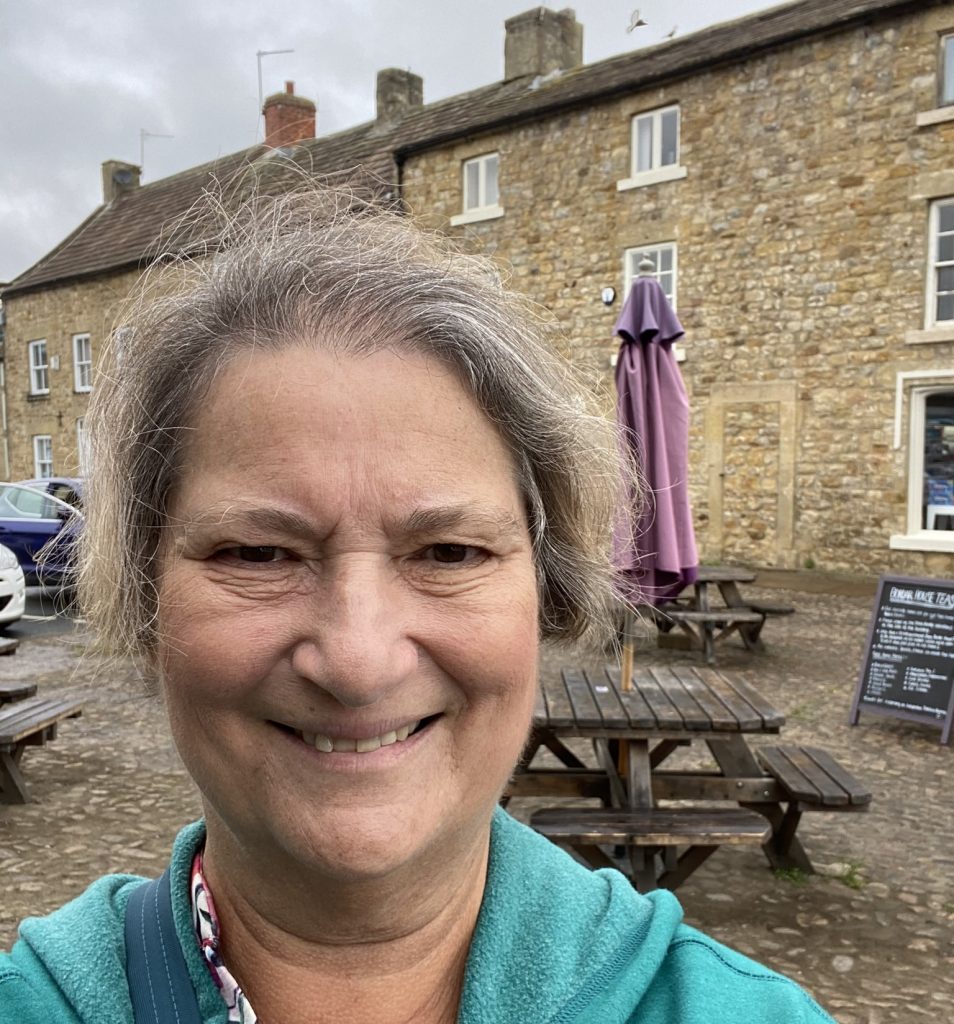
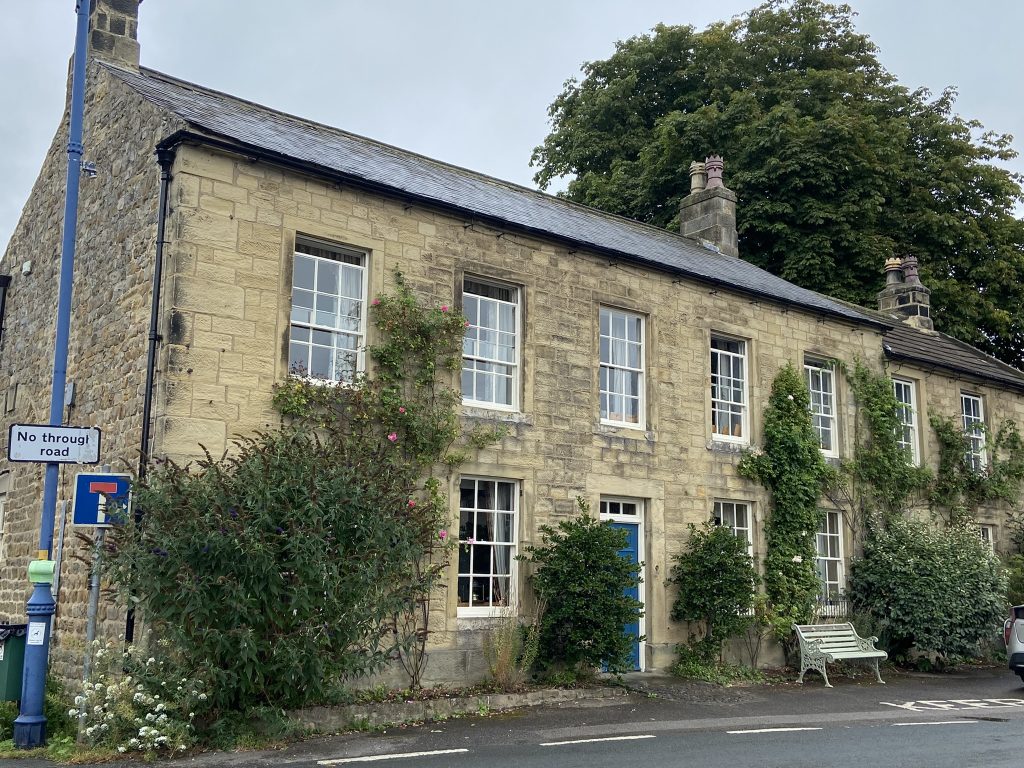
My grandmother was born in Masham in 1906 so visiting it has a special significance. Her family left soon after she was born (they moved a lot) so my grandmother likely never knew much about the place.
I stand in the middle of the market square and try to imagine my great-grandmother holding my grannie in one arm while she held the hand of my great-aunt. The town now is marketed as a good home base for touring the Yorkshire dales, but back in my granny’s time I think it must have been quite bleak.
Jervaulx Abbey
Matt takes us to lovely Jervaulx Abbey, a hauntingly beautiful place privately owned and maintained by the Burdon family. The Abbey, like all the abbeys in the area, was plundered and pillaged during the Dissolution of the Monasteries in the 16th century.
The ruins are charmingly untouched, with wild flowers, shrubs and trees growing freely in a peaceful country setting.
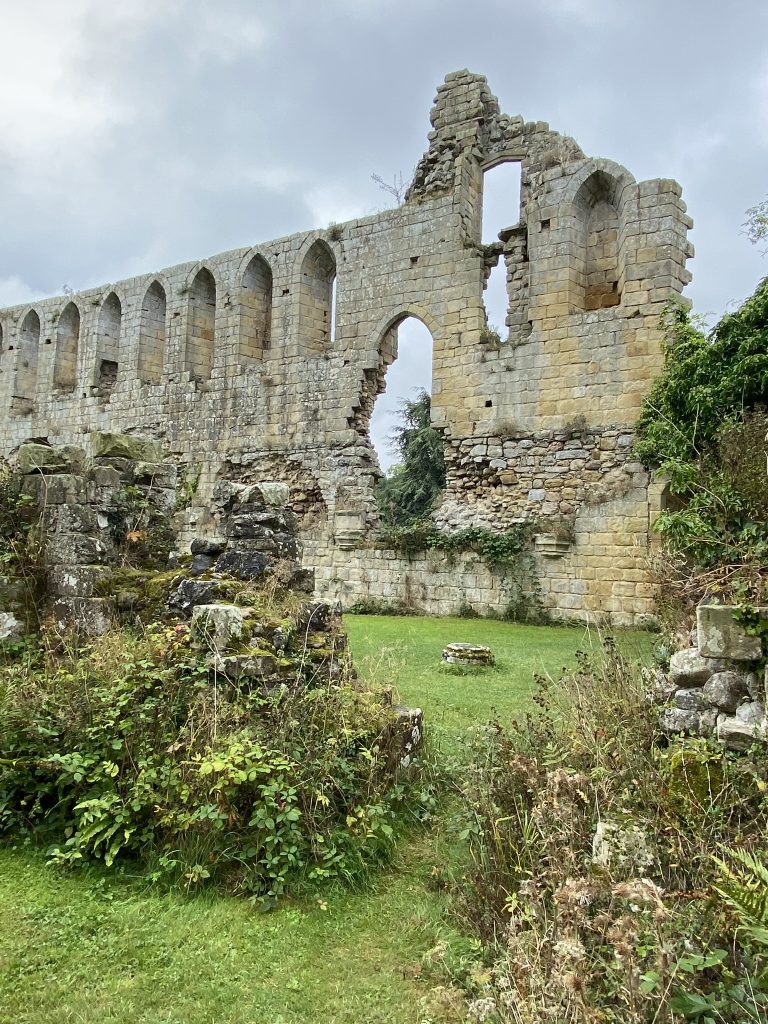
Bolton Castle
Another quick stop at Bolton Castle gives me just enough time to make the acquaintance of some wild boars who don’t look very wild. As I approach their enclosure, they barely twitch a whisker. And then I take out a bag of crisps and the sound wakes up several of them. They charge towards the wire fence, ears perked. I have to tell them no. After staring at me hopefully for a few minutes, they amble back to find the patch of dirt they’d vacated and resume their recumbent positions.
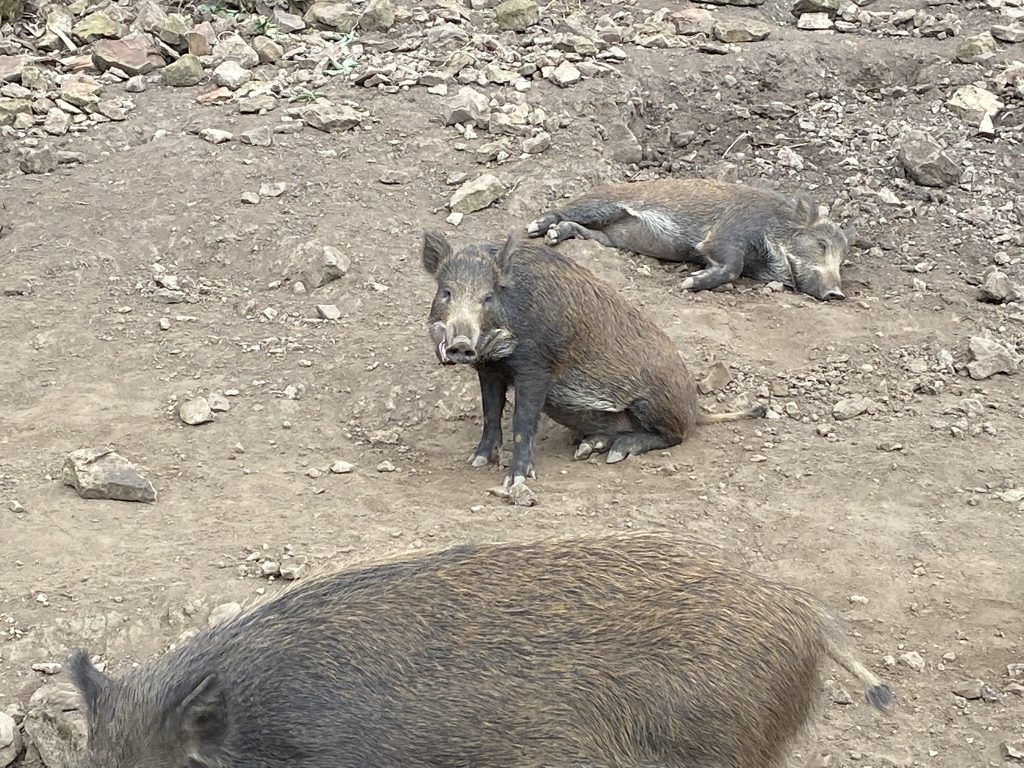
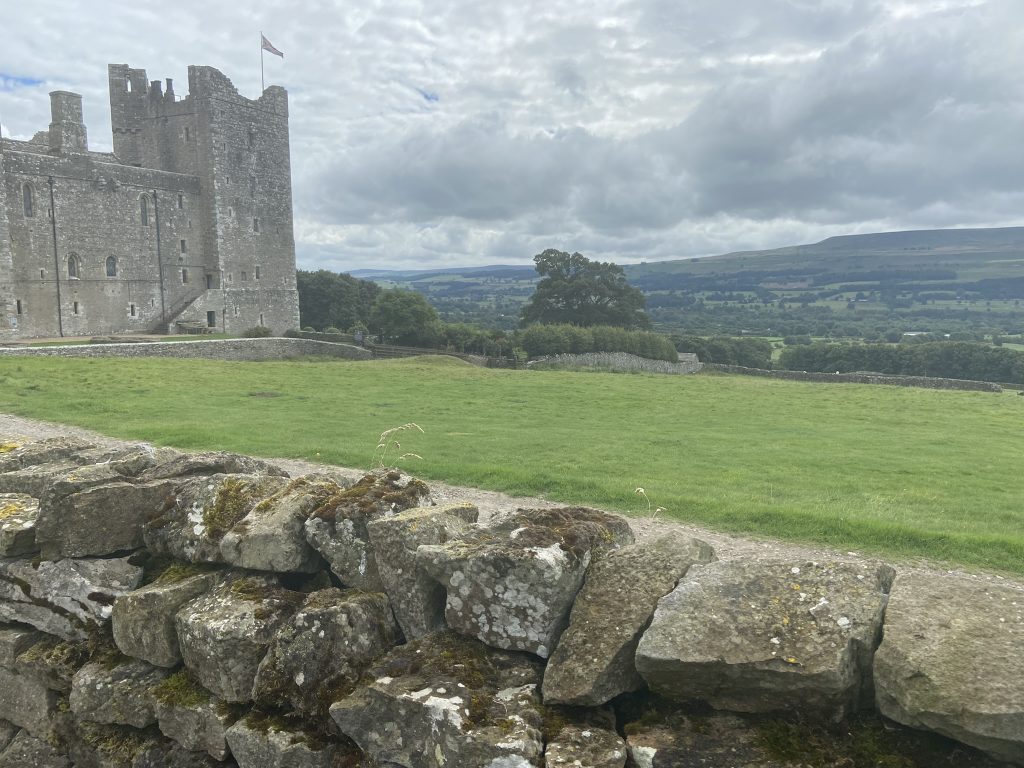
Mary, Queen of Scots was imprisoned in Bolton Castle along with a large entourage of servants (so she couldn’t have been too deprived) between 1568 and 1579. But her life went from bad to worse following her Bolton Castle stint until finally she was beheaded by order of her cousin Elizabeth I in 1587.
Aysgarth Falls
Next stop is a quick one to view Aysgarth Falls on the River Ure. It’s a spectacular triple flight of waterfalls made famous as the place where Kevin Costner as Robin Hood duels with Little John in Robin Hood: Prince of Thieves.
Hawes
We drive up hill and down dale to the village of Hawes in Wensleydale, home of Wensleydale cheese. Matt drops us at the Wensleydale Creamery where I sample several varieties of cheese and purchase a hunk of Wensleydale along with a package of oatcakes. After cheesing out, I walk down to the village and have lunch at a pub.
There’s not a whole lot to see in Hawes, but it is extremely charming, with the added bonus of being the target of the Hawes Yarn Bombers. The fruits of the crochet labors are all over the town and include a large tableau of crocheted characters from Shrek. I text pictures to my daughter Julia who is also a crochet artist.
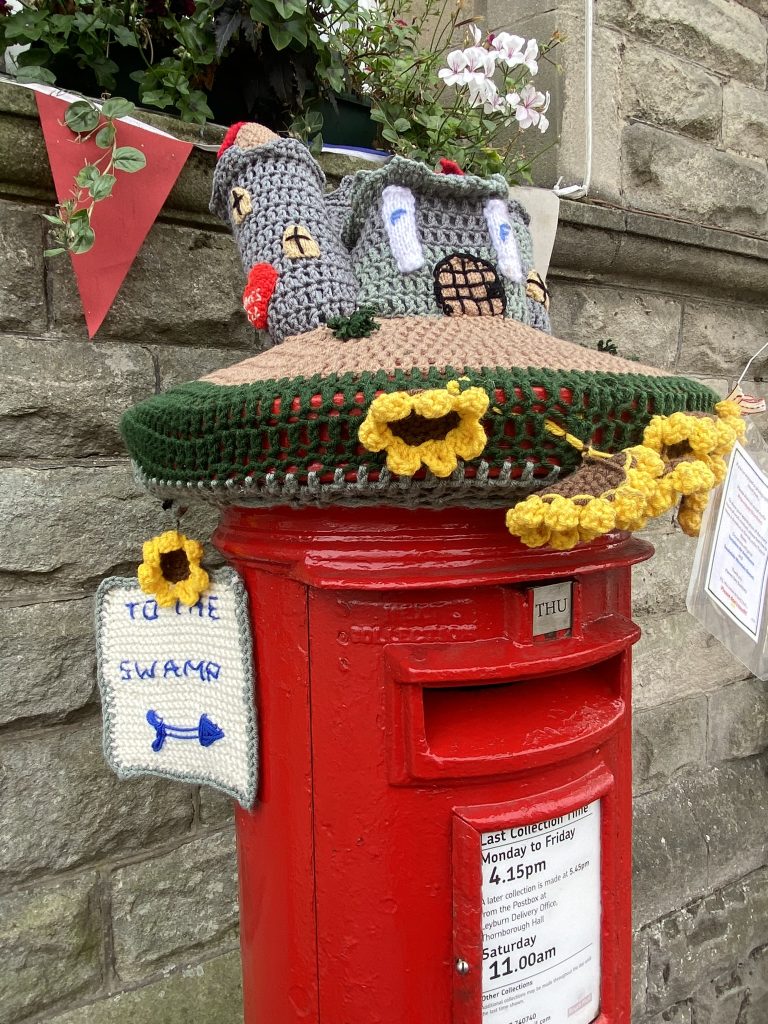
Butter Tubs Pass
Matt drives us up very narrow roads to enjoy stunning vistas of the Yorkshire countryside. What a place! We stop briefly at Butter Tubs Pass that crosses high moorland between Wensleydale and Swaledale. The limestone potholes known as the butter tubs are so named because farmers on their way to market would stop on hot days at the top of the climb and lower their tubs of butter into the limestone potholes to keep the butter cool.
Here’s a video taken at the top of the pass showing both the Yorkshire moors and the Yorkshire dales. Pretty darned spectacular!
Leeth
The picture-perfect little town of Leeth is our final stop. Matt advises us to get ice cream made at a local creamery. My cone of honeycomb and ginger ice cream tastes as good as it sounds.
I shoot this video while standing on the village green (and holding my ice cream cone):
Recommended Yorkshire Tours
I wholeheartedly recommend the tours I took with these two companies:
Both companies provided good value for money, excellent guides, scenic drives, and well-planned stops.
Here are two more tours offered by Tiqets.com, one of my affiliates. If you click on one of the links and end up taking a tour with Tiqets.com (any tour), I get a small commission.
Conclusion
My two full days and three nights in York come to a close as I board the train for a quick trip north to Durham where I will spend three nights. Have you visited York and Yorkshire? What suggestions do you have for enjoying this glorious area of England? Please share in the the Comments below.
Here are more posts about traveling in England:
